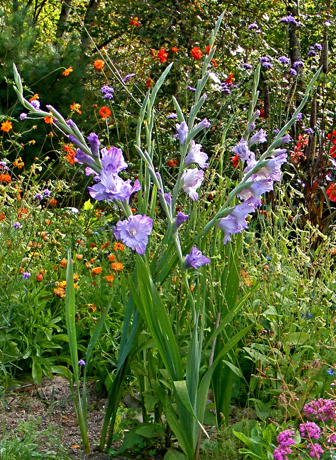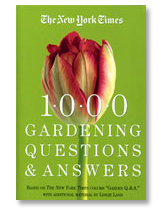The New U.S.D.A. Climate Zone Map

Zone 6 zone denial tip: standard hybrid gladioli are reliably hardy only to zone 9 - or 8b, maybe - but if you have well drained soil, plant them 5 or 6 inches deep and mulch heavily in fall (in this case before the ground freezes), there’s a good chance they’ll come back.
By now you’ve probably gotten the word: the long awaited, massively updated USDA Climate Zone map, the first revision since 1990, has finally arrived. And – insert giant snarky “this is news?” – it shows large swaths of the country have moved up at least a half zone.
In 1991, when I got together with Bill and began gardening in the Hudson Valley, I could joke that my new life didn’t net me a single climate zone, even though the NY garden is about 300 miles southwest of the one in Maine. Until a couple of weeks ago, they were both in zone 5b. Now, while New York remains 5b – by the skin of its teeth, from the looks of things – Maine has been promoted to 6a.
Of course the difference between the two may well be less than the full 5 degrees between half zones. Same with the big chunk of Nebraska that’s now 5a instead of 4b. It’s also possible that Chicago, a heat island, may have remained exactly the same while getting a higher zone assignment because of better measurement.
But whatever the physical changes, most of the numbers did go up. The USDA, however, refuses to draw what appear to be obvious conclusions.
Perhaps not surprisingly, there has been a lot of flapdoodle* about how the zone changes are strong proof of global warming and the USDA is simply stonewalling. There has also been a fair amount of wishful thinking along the lines of “I thought it wouldn’t be hardy here, but now I know I can grow it. Yay!”
Well, yes and no. USDA representative Kim Kaplan doth perhaps protest too much when insisting that the new map differs so fundamentally from the old that the two cannot be compared. Given the unanimity of projections of increasing warmth in future, it could be quibbling to maintain that the 30 years of data behind the new map is weather, not climate, because climate measures brackets of at least 50 years. And when it comes to wishful thinking, no one with any gardening knowledge would deny that plant hardiness is indeed an increasingly mobile target.
But all that said, I don’t think it would hurt to calm down a little and stop making the poor map carry far more weight than it should. On the first count, there are a lot more robust proofs of global warming (check out this government sanctioned analysis of trends in the Southeast, for instance, if you really want to have your pants scared off.) On the second count, it pays to remember that average winter lows – the only thing measured on the map – are by no means the single factor influencing plant survival; and when it comes to climate change the challenges far outweigh the benefits, even at the home garden level.
Some Factors Other Than the Thermometer That Influence Winter Survival of Plants
Time to harden off. When cold comes gradually, plants have a chance to toughen up in preparation for winter. When cold comes suddenly, plants may be killed by temperatures they could otherwise sail through unscathed.
Duration of the coldest temperatures. A plant rated hardy to -10 is more likely to survive a few hours of -15 than ten straight days of -5.
Winter soil moisture. Dry climate plants from lavender to cactus care a lot more about drainage than they do about air temperature.
Yearly rainfall. Seattle and Tucson have the same zone number but are not otherwise similar. Moisture needers and drought needers alike will go into winter deeply stressed if grown in the wrong place, and that weakness can finish them off when deep cold is added.
Late summer and fall care. Nitrogen fertilizer spurs tender growth that’s vulnerable to winter kill. Late pruning does the same thing.
Snow cover. A deep fluffy blanket of snow that lasts all winter will protect plants (especially perennials) from cold that would kill them if the ground were bare.
Some Gardeners’ Problems Headed This Way As a Result of Climate Change
Rapid temperature swings. A long mild fall followed by a plunge into the deep freeze, and/or a very early spring, followed by a plunge into the deep freeze.
Extreme weather events. Extended droughts, torrential rains, hurricane force winds.
Shorter winters. Plants like apples, peonies and lilacs that must have a long winter sleep can languish with too little rest. Insects and diseases once kept in check by extended cold will have higher rates of survival.
Less reliable snow cover, more frequent ice storms. Snow protects; ice kills.
Hotter summers. Northerners will have better luck with heat-loving annuals from tomatoes to moonflowers. Southerners may well have less; too much heat prevents fruit set and pushes annual flowers into early graves. The region of happiness for plants that must have cool nights even in summer (peas, delphiniums, rhododendrons, sugar maples) is headed toward Canada.
A Few Coping Strategies may be found here.
* Some back story on the flap.
Whatever its limitations, the USDA hardiness zone map has long been a widely recognized metric. Breeders and nurseries use it to rate and label plants. Scientists use it (along with a lot else) when investigating things like the spread of invasive weeds. The USDA itself uses the map to set some crop insurance standards.
Not chopped liver; and by the time the century turned, it was clear to all that the 1990 map was both insufficient and inaccurate. The USDA commissioned a new one from the American Horticultural Society, which had produced zone maps before. Projected appearance date was 2003.
But then the map didn’t show up – or rather it didn’t show up for long. As I remember it, there was a new version on the AHS website, but only very briefly. The curious were told it went away because it was just a draft; the USDA was not satisfied, and revisions were under way.
This was the party line for quite a while. During this while, we were enjoying the G.W. Bush administration, increasingly notorious for its disinclination to confront man made climate change. People began to think dark thoughts.
These thoughts were not brightened when, in 2006, the Arbor Day Foundation published an updated zone map of its own, using some (but not all) of the same data as the rejected AHS draft. The ADF website provides an animation of the old map morphing into the (ADF) new one. It is not reassuring.
More grumbling. More Bush administration. More delays, now routinely attributed to the difficulty of producing a sufficiently sophisticated, web friendly interactive map.
Not so fast forward to January 25th, 2012. The new map is introduced at the National Arboretum. Distant journalists are invited to attend via webinar. I attend.
Neato! The thing is terrific. It really IS a great leap forward – for doing what it’s supposed to do, anyway. One need only enter a zip code to get the corresponding zone assignment, and there is a lot of other information there for the drilling down.
The introduction ceremony concludes with a question period. Various reporters ask questions. The most vocal questioners do not appear to be gardeners and what they really, really want to know is why the long suffering Ms. Kaplan, who has been fielding these enquiries ever since the flap began, will not knuckle under and admit that the map proves global warming is undoubtedly here. She won’t do it. (Her reasons are detailed on the map site, under “what’s new?”)
So, official word is still that the map was not delayed – perhaps by underfunding? – during the previous administration, which may or may not be true. But in fairness, nobody’s trumpeting its appearance as the return of sanity, either. So at the very least the USDA is an equal opportunity sphinx.















While I chortle at the dark humor of the Bushies era, I wince and cringe with fear of the unknown. The underlying theme being “how bad will it get and how fast?”. Whilst being nestled comfortably near Canada, I have great trepidation for the rest of the country- famine, catastrophe, great wailing and gnashing of the teeth… Pray tell, what miracle drug is Ms. Kaplan on to keep such a cool visage?
Hi Ladleah,
Wish I had some reassurance, but I don’t. And I’m afraid proximity to Canada isn’t going to help all that much, especially in the unseasonably hot spring followed by horrid frost department. Interesting question about Ms. K – maybe you ought to ask her, so we can all flock out to get some of whatever it is. That fact that it’s her job to remain unrattled may have something to do with it, because she is for sure living in an area (environs of Washington DC) that’s really getting hammered by all this and I don’t mean politically.
I’ve been robbed. My part of Maine was knocked down a half zone. I knew deep down that I wasn’t really in 5a but I pretended. The new map put me back in 4b where I rightfully belong. Even though I knew, seeing it in print made me wince a little.
Oh Robin,
My sympathies! … except for the part where I hope this means you’ve still got decent snow cover. Thanks so much for telling us what has befallen you. Knowing an actual person whose zone went down instead of up helps make (at least a part of) Ms. Kaplan’s argument real: because the new map is more accurate, some places got assigned to colder, not warmer zones. Other than you, it sounds as though it’s the folks in the mountains out west who got pushed backwards the most. Also, the part where you say “I knew deep down,” strengthens MY argument (in the coping link): almost everyone has a personal climate zone – or zones – depending on exact location, shape of terrain, adjacent buildings etc., and that’s the only one that really matters.
I also checked the link to weather and climate forecasts for the Southeast. Yes it is frightening. The real harbinger of the effects of global warming was the insurance industry, which late in the Bush administration’s years, set up new guidelines for insuring (or more likely NOT) insuring coastline and especially shoreline property. They accepted the data and started using it before any other entity.